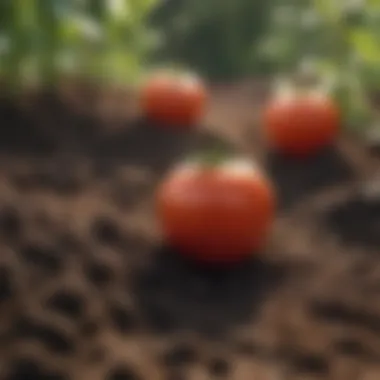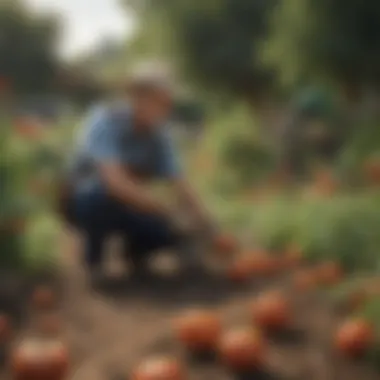Optimal Timing for Growing Tomatoes in Southern California


Intro
Tomatoes are one of the most popular and rewarding crops to grow in Southern California. Understanding the optimal timing for planting these fruit-bearing plants is essential for a successful harvest. Various factors influence planting decisions—from climate variations across the region to specific care needs of different tomato varieties. This article delves into these aspects, offering guidelines for both novice and experienced gardeners.
The growing season in Southern California is relatively long. However, knowing the right time to plant can make a significant difference in yield and quality.
Factors such as soil quality, temperature fluctuations, and local microclimates should be carefully considered. Some gardeners might even experiment with different planting dates to see what works best for their garden. Armed with the right information, gardeners can elevate their experience while considering their personal styles and preferences in growing tomatoes.
Design Inspiration
Trending Styles
When planning your tomato garden, think beyond the basics of planting. Different growing styles can influence the health and yield of your tomatoes. For instance, vertical gardening is highly advantageous in smaller spaces. This method encourages air circulation, promotes sun exposure, and can even improve fruit quality. Raised beds also remain in vogue, as they offer excellent drainage and warm soil, conditions preferred by tomatoes.
Color Palettes
Choosing tomato varieties can also be a matter of aesthetics. Some gardeners prefer the classic red varieties, while others enjoy heirlooms like Cherokee Purple or Brandywine, which bring a splash of purple and pink hues. Consider creating a palette that also harmonizes with the rest of your garden, enhancing not only the functionality of the space but also its visual appeal.
Practical Tips
Maintenance & Care
Proper care is vital for healthy tomato plants. Start by testing your soil. Tomatoes thrive in well-draining soil, rich in organic matter. Amending your garden with compost can enhance soil fertility. Monitor water levels carefully as tomatoes prefer consistent moisture. Overwatering can lead to root rot while underwatering affects fruit development.
Fertilization is also crucial. Applying a balanced fertilizer can promote robust growth. As tomatoes mature, switching to a fertilizer higher in potassium can boost fruit production.
Budgeting & Planning
Budgeting for your tomato garden involves more than just seed costs. Consider investments in soil amendments, fertilizers, and tools like trellises or cages. Efficient planning can prevent unnecessary expenses. It may be beneficial to start seeds indoors or purchase seedlings from local nurseries. This approach can ensure you select the optimal varieties suited to your unique environment.
Understanding the Climate in Southern California
Understanding the climate in Southern California is essential for successful tomato planting. The climate can profoundly influence plant growth, fruit yield, and overall gardening success. Homeowners and gardening enthusiasts must consider several factors such as temperature, rainfall, and local conditions specific to their neighborhoods.
The region's climate can be characterized by its warm, dry summers and mild, wet winters. This gives a long growing season, but it also presents unique challenges. Knowing when to plant tomatoes ensures that gardeners can take full advantage of this stretch, aligning their planting schedule with periods optimally suited for tomato growth.
Characteristics of Southern California's Climate
Southern California features a Mediterranean climate, which is one of the reasons why it is such a popular location for growing a variety of crops, including tomatoes. The summers can be hot, with temperatures often exceeding 85°F (29°C) while winters are cooler and more temperate. The rainfall is primarily concentrated in the winter months, affecting soil moisture levels early in the year.
The growing season typically spans from early spring to late fall. This extended period allows for multiple plantings, especially if gardeners are careful to avoid cooler overnight temperatures.
- Heat: Tomatoes thrive in warm weather. However, excessive heat, particularly above 90°F (32°C), can hinder pollination, leading to poor fruit set.
- Humidity: Generally low in Southern California, low humidity helps prevent fungal diseases that can plague tomato plants.
- Sunlight: Tomatoes require full sun, ideally 6 to 8 hours a day. South-facing yards are often best positioned for optimal sunlight.
Microclimates and Their Impact on Planting
Southern California is home to various microclimates that can affect tomato planting. Microclimates are small areas where the climate differs from the surrounding region. These can be influenced by topography, proximity to the ocean, and urban development.
For example:
- Areas close to the coast may have cooler temperatures, delaying planting times.
- Valleys could heat up faster and may encourage earlier planting.
- Hillsides might have different drainage patterns, affecting soil moisture.
Understanding these microclimates can help gardeners make better decisions about when and where to plant tomatoes. Adapting to these local conditions will ultimately maximize yield and produce healthier plants.
"Recognizing and adapting to microclimates is the key to successful gardening in Southern California."
In summary, understanding the distinct climate of Southern California and its microclimates is crucial for effective tomato planting. This knowledge enables gardeners to optimize their planting schedules and ensure better growth.
The Growing Season for Tomatoes
The growing season for tomatoes is a crucial aspect of gardening in Southern California. Understanding this season allows gardeners to maximize their yield and avoid common pitfalls related to timing. The key elements include the duration of the growing season, frost dates, and the characteristics of tomato plants that dictate the appropriate planting times. Knowing when to plant can lead to healthier plants and abundant harvests.
Defining the Tomato Growing Season


The tomato growing season in Southern California typically spans from late winter into the late fall. Ideal conditions allow for a long growing period, with ample warmth and sunlight.
This region experiences mild winters and warm summers, making it suitable for starting seeds indoors as early as January. By transplanting seedlings outside around March or April, gardeners take advantage of the optimal temperatures that tomatoes thrive in.
When defining this season, it is important to recognize that tomato varieties behave differently.
- Determinate varieties are often bred for specific harvest times, meaning they will mature all at once.
- Indeterminate varieties continue growing and bearing fruit throughout the season.
Therefore, knowing the specific variety allows for planning around the expected maturity date.
Frost Dates and Their Relevance
Frost dates play a pivotal role in determining the success of a tomato crop. In Southern California, the last frost date usually occurs between mid-February and mid-March, depending on the specific zone. Accurate knowledge of these dates can help gardeners avoid planting too early when there is still a risk of frost damage.
The risk of frost can stifle early growth, stunt development, or even kill young plants.
To ensure successful tomato cultivation, gardeners can:
- Monitor local forecasts for frost warnings.
- Use protective covers during unexpected cold spells.
Ultimately, understanding and accounting for frost dates are essential for achieving a fruitful tomato harvest. Once the frost threat has passed, the window for planting opens, allowing for optimal growth in the warm Southern California climate.
When to Start Tomato Seeds Indoors
Starting tomato seeds indoors is a critical step in ensuring a successful gardening experience, particularly in Southern California where the growing season is generally long but can be unpredictable. This method allows for an extended growing period and better management of environmental risks. By beginning the germination process early, gardeners have more time to nurture seedlings before transplanting them outdoors, thus optimizing yield and health of the plants.
Timing for Indoor Seed Germination
In Southern California, the best time to start tomato seeds indoors is roughly 6 to 8 weeks before the last expected frost date. This timeframe usually falls between late January and early March, depending on your specific location. Seed packets often indicate the recommended sowing times; adhering to these can significantly influence the success rate of germination. An awareness of local climate and frost dates is essential.
The average last frost date in Southern California varies. For many areas, it is around mid-April. Therefore, calculating back from this date will guide you on when to start your seeds indoors. This can protect them from potential chill that could harm the plants during their juvenile stages.
Optimal Conditions for Seedling Growth
Creating the right conditions for seedling growth is vital for robust tomato plants. Here are several factors to consider:
- Temperature: The ideal temperature for germinating tomato seeds is between 70°F and 80°F. Using a seedling heat mat can maintain consistent warmth, promoting faster germination.
- Light: After the seeds germinate, they require adequate light. A south-facing window or grow lights can provide the necessary illumination. Seedlings should ideally receive 12 to 16 hours of light each day to prevent legginess.
- Humidity: Keeping humidity levels high during the early growth period can enhance seedling health. This can be achieved by covering trays with a plastic dome until the seeds sprout, then gradually removing it to acclimate the plants.
- Water: Seedlings need consistent moisture. The soil should be kept damp but not soggy. Overwatering can lead to root rot, while underwatering can cause seedlings to wilt and die.
In summary, starting tomato seeds indoors at the appropriate time, while providing the right conditions for growth, can set the stage for a productive garden season. By paying attention to these elements, gardeners can ensure healthier plants ready for outdoor transplanting.
Transplanting Tomato Seedlings Outdoors
Transplanting tomato seedlings outdoors marks a crucial phase in the cultivation process. This step determines the plants' ability to thrive in their new environment. Understanding the subtleties of this transition can make a significant difference in your harvest. It is important to pay attention to factors like soil temperature, local climate variations, and the specific demands of the tomato plants you are working with.
The rate of growth after transplantation heavily relies on the choices made in this stage. If performed correctly, the seedlings establish quickly, leading to robust plants that bear fruit efficiently. Conversely, mistakes during this phase can stunt growth and negatively affect yields. Therefore, knowledge about ideal conditions is essential to ensure that your tomatoes reach their full potential.
Ideal Soil Temperature for Transplanting
Soil temperature is a key determinant for successful transplanting of tomato seedlings. Ideally, the soil temperature should be around 60°F (15.5°C) to 75°F (24°C). Within this range, seedlings acclimatize better and roots develop more efficiently.
Transplanting when the soil is too cold can slow growth and make the seedlings vulnerable to diseases. Conversely, very warm soil can stress the seedlings, potentially leading to wilting or poor establishment.
To check soil temperature, use a simple soil thermometer. Monitor the temperature for a few days before transplanting to select an optimal window. Pay attention to evening temperatures as well since they can affect the overall conditions. Taking these steps can enhance the likelihood of a successful transplanting experience.
Factors Influencing Transplant Success
Several factors impact the success of transplanting tomato seedlings outdoors. Here are some critical considerations:
- Timing: Planting too early or too late can expose seedlings to stress due to unexpected weather conditions.
- Acclimatization: Gradually acclimate seedlings to outdoor conditions before transplanting them fully. This process, known as hardening off, helps reduce transplant shock.
- Moisture Levels: Ensure the soil is adequately moist before transplanting. Dry soil can impede root establishment, while overly wet soil can promote rot.
- Spacing: Allow enough space between seedlings to encourage airflow and reduce competition for nutrients. Proper spacing can prevent issues such as blight, which thrives in crowded environments.
In summary, each of these factors plays a vital role in determining how well your tomato seedlings will adapt once they are transplanted outdoors. Taking the time to understand and implement these considerations will result in healthier plants and, ultimately, a more prosperous harvest.
Types of Tomatoes and Their Planting Times
Understanding the specific types of tomatoes and their optimal planting times is vital for successful gardening in Southern California. The region’s varied climate means that the timing for planting can significantly affect the yield and quality of tomato crops. Moreover, the distinctions between tomato varieties can guide gardeners in making choices that align with their local conditions.


Choosing the right type of tomato can also influence factors such as space management, harvest timing, and even pest resistance. Therefore, delving into the characteristics of different tomato varieties ensures that gardeners can maximize their gardening success.
Determinate vs. Indeterminate Varieties
Tomatoes are generally categorized into two types: determinate and indeterminate varieties.
- Determinate Tomatoes: These typically grow to a defined height, are bushy, and produce fruit all at once. The timing for planting determinate varieties can be a bit more flexible, as they mature more quickly. Gardeners can expect a shorter harvest period, which can be advantageous for those wishing to make salsas or sauces quickly. Varieties like 'Roma' and 'Celebrity' are popular determinate options in Southern California.
- Indeterminate Tomatoes: These varieties continue to grow and produce fruit throughout the growing season. They tend to yield fruit in a staggered fashion, making them suitable for prolonged harvests. However, this also means that they often require more support as they can grow tall and vine-like. Varieties such as 'Big Boy' and 'Cherokee Purple' exemplify the indeterminate type. Planning the planting time for these tomatoes is crucial as they benefit from longer growing seasons.
In general, indeterminate varieties are recommended for gardeners with enough space and those looking for a continuous harvest.
Selecting the Right Varieties for Your Region
Selecting the suitable tomato varieties for Southern California involves considering factors such as local climate, soil conditions, and pest resistance.
- Climate Compatibility: The hot summers and mild winters in Southern California allow for the cultivation of various tomato types. However, it's essential to choose varieties that can withstand the heat, particularly during peak summer months.
- Disease Resistance: Certain tomatoes are bred specifically to be resistant to common diseases that affect crops in this area, such as blossom end rot and gray mold. Varieties like 'Better Boy' offer such resistance while still providing a rich flavor.
- Growth Habit Considerations: Homeowners with limited garden space may prefer determinate varieties, while those with larger areas can experiment with several indeterminate types for a vibrant garden.
To summarize, understanding the differences between determinate and indeterminate varieties helps in planning for optimal tomato planting in Southern California. Selecting varieties that align with local conditions will enhance growth and ensure a bountiful harvest.
"The choice of tomato varieties is a critical aspect of gardening that can influence yield, flavor, and experience in the garden."
Overall, gardeners should be proactive in assessing their conditions and choosing appropriate varieties, allowing them to enjoy the full potential of their tomato-growing efforts.
Watering Considerations for Tomato Plants
Watering is a critical component of growing healthy tomato plants. Proper hydration influences fruit production, plant vigor, and overall health. Balance is key, as both overwatering and underwatering can lead to serious consequences. Understanding how to approach watering will maximize your efforts and yield.
Watering Schedule During Planting
Creating a consistent watering schedule during planting helps establish robust tomato plants. During the early stages, new seedlings require careful attention.
- Initial Watering: After transplanting seedlings outdoors, water them thoroughly. This helps settle the soil and removes air pockets. Ensure the water penetrates down to the root zone.
- Frequency: For the first few weeks, keep the soil consistently moist but not saturated. A schedule of watering every 2 to 3 days is often sufficient. As the plants develop, you can adjust this based on weather conditions and soil drainage.
- Time of Day: Watering in the morning is ideal. It allows the plants to absorb moisture before the heat of the day. Avoid late-night watering to prevent fungal diseases, as damp foliage overnight creates an inviting environment for pathogens.
Effects of Overwatering and Underwatering
Understanding the effects of both overwatering and underwatering is crucial for tomatoes.
- Overwatering: This can lead to root rot, a condition that suffocates roots and hinders their ability to absorb nutrients. Signs include yellowing leaves, wilting, and, in severe cases, plant death. Ensure the soil has good drainage to mitigate this risk.
- Underwatering: Insufficient water can stunt growth and limit fruit development. Plants may display signs such as curling leaves, dry patches, and a lack of vigor. During hot spells, more frequent watering might be necessary to prevent stress.
In summary, a well-planned watering strategy helps ensure healthy plants and optimal fruit production. Paying attention to moisture levels and adjusting your techniques based on the plants' needs is essential for successful tomato gardening.
Proper watering is often the difference between a bountiful harvest and a disappointing yield.
Soil Preparation Techniques
Soil preparation is a critical step in the process of planting tomatoes. Having the right soil can greatly impact the success of your tomato plants, influencing growth, yield, and health. In Southern California, conditions can vary significantly from region to region, so understanding and preparing the soil properly is vital. The benefit of investing effort into soil preparation includes enhanced nutrient availability, better water retention, and improved root development for the plants.
Assessing Soil Quality for Tomato Growth
Before planting, it is essential to evaluate the soil quality. This involves checking several key factors:
- Soil Texture: Determine whether you have sandy, loamy, or clay soil. Loam is considered ideal for tomatoes because it retains moisture and provides adequate drainage.
- pH Levels: Tomatoes prefer a pH level between 6.0 and 6.8. Test the soil with a pH meter or kit. If the pH is too low or high, this can hinder nutrient absorption.
- Nutrient Content: Conduct a soil nutrient test to analyze levels of nitrogen, phosphorus, and potassium. This helps to identify any deficiencies or surpluses.
By assessing these elements, you can gain insights into your soil's condition and how it can support your tomato plants. Well-prepared soil can lead to healthier plants, ultimately resulting in a better harvest.
Amending Soil for Optimal Results
Once soil quality has been assessed, the next step is to amend it as needed. Here are some common amendments and how they can benefit tomato plants:
- Organic Matter: Adding compost enriches the soil, improves its texture, and fosters beneficial microorganisms. Use well-rotted compost or aged manure to ensure nutrients are available.
- Nitrogen-Rich Additives: If your soil test shows low nitrogen levels, consider using blood meal or a fish emulsion. This promotes strong foliage and overall plant growth.
- Lime or Sulfur: To adjust pH levels, lime can be added to acidify the soil, while sulfur helps to lower pH.
- Mulch: Applying organic mulch, such as straw or wood chips, can help retain moisture, suppress weeds, and gradually add nutrients back into the soil as it decomposes.
Implementing these amendments according to soil tests will ensure that your tomato plants have the best possible conditions for growth. As you prepare your soil, keep in mind that it is an ongoing process. Soils can change over time, and continuous assessment and amendment can support a thriving garden.
"The foundation of a successful garden starts with the soil. Treat it well, and it will reward you with abundant harvests."
By concentrating on these preparation techniques, you will create a robust environment for your tomato plants, guiding them through their growing season with resilience.


Pest and Disease Management
Pest and disease management is a fundamental aspect of cultivating tomatoes in Southern California. Effective management practices are essential to ensuring a healthy tomato crop, free from the threats that pests and diseases pose. Understanding the specific threats to tomato plants and employing appropriate management techniques can prevent significant losses.
The unique climate of Southern California creates an environment that can be conducive to various pests and diseases. Thus, gardeners must be proactive. Proper management not only enhances the yield but also leads to better fruit quality.
Another benefit of effective pest and disease management is that it can sometimes reduce the need for chemical interventions. This aligns with sustainable gardening practices. With awareness and vigilance, it is possible to minimize losses while cultivating a thriving garden.
Common Pests Affecting Tomato Plants
Tomato plants are susceptible to several pests, each posing distinct threats. The following are some of the common pests encountered:
- Aphids: Small insects that suck plant sap, weakening plants. They can also transmit viruses.
- Tomato Hornworms: These caterpillars can strip a tomato plant of foliage in a very short time.
- Whiteflies: Another sap-sucking insect that can introduce viruses.
- Spider Mites: Tiny pests that create webbing and cause stippling damage on leaves.
Effective monitoring is crucial. Regular inspections of plants can help identify the presence of these pests early. Gradual population growth may lead to extensive damage if not addressed.
Preventative Measures and Treatment Options
Preventative measures are critical in keeping tomato plants healthy. Here are some strategies:
- Crop Rotation: Avoid planting tomatoes in the same spot every year to break pest life cycles.
- Companion Planting: Some plants deter pests; for example, planting basil near tomatoes can help.
- Regular Inspections: Check under leaves and stems for signs of pests or disease.
- Mulching: Helps maintain soil moisture and reduce weed competition.
- Using Physical Barriers: Row covers can protect young plants from pests.
When pests are already present, consider treatment options such as:
- Insecticidal Soap: An easy and organic method to control soft-bodied insects.
- Neem Oil: Effective against various pests and some fungal issues.
- Handpicking: Especially for larger pests like hornworms.
In summary, understanding pests and diseases alongside implementing effective management strategies are key to successfully growing tomatoes in Southern California.
Proper management not only enhances the yield but also leads to better fruit quality.
Harvesting Tomatoes
Harvesting tomatoes is a crucial stage in the gardening process. The quality and taste of the tomatoes depend significantly on the time of harvest. Understanding the right timing for harvesting ensures that you enjoy the best flavors and nutrients from your crop. This section addresses key elements related to harvesting, such as indicators of ripeness and best practices to follow.
Indicators of Ripeness
Knowing when tomatoes are ripe is essential. Tomatoes do not continue to ripen well once harvested, so picking them at the right time is vital. There are several signs to look for:
- Color: A ripe tomato will have a vibrant, consistent color, whether it is red, yellow, or another hue depending on the variety. Inconsistent color may indicate that the fruit is not yet ready.
- Firmness: Ripe tomatoes should yield slightly to gentle pressure. If they are too hard, they need more time on the vine. However, if they are overly soft, they may be overripe.
- Glossy Skin: The skin of ripe tomatoes tends to appear shiny. Dull skin can be a sign of immaturity.
- Vine Attachment: Tomatoes should come off the vine with a gentle tug. If you need to pull hard, they are likely not ready yet.
It is advisable to check your plants daily as the growth can change quickly, especially in the warm climate of Southern California.
Best Practices for Harvesting
To preserve the quality of your tomatoes, certain practices should be followed during the harvesting process:
- Use Clean Tools: Make sure to use clean cutting tools to prevent any disease transfer to the tomatoes.
- Harvest in Dry Conditions: Pick tomatoes during dry weather. Gathering them when wet can lead to mold and spoilage.
- Handle with Care: Avoid squeezing the fruits too tightly. Handle them carefully to prevent bruising.
- Store Properly: After harvesting, store tomatoes in a cool, dry place. If you plan to consume them soon, keep them at room temperature. Refrigeration is not recommended as it can alter the flavor and texture.
- Regular Harvesting: Regularly harvesting ripe tomatoes encourages the plant to produce more fruit. It also helps to keep the plant healthy.
Important: Harvesting tomatoes at the right time maximizes both flavor and nutritional value.
By paying attention to ripeness indicators and following best practices, gardeners can ensure they get the most out of their tomato plants. Proper harvesting leads to a rewarding experience, enhancing not only the flavor of the tomatoes but also the satisfaction of cultivating them.
Culmination
In the context of planting tomatoes in Southern California, understanding the timing is pivotal for successful yields. This conclusion synthesizes insights on various factors that influence planting periods. Recognizing climate variations, frost dates, and soil conditions ensures better decision-making. This knowledge significantly impacts the growth rate and fruit quality of tomato plants.
Recap of Key Planting Considerations
To summarize, several elements are core to successful tomato planting:
- Climate Understanding: Southern California's climate showcases both sunny days and occasional cool spells which affect growth cycles. Monitoring local weather patterns is crucial.
- Growing Season Dates: Start seeds indoors six to eight weeks before the last frost date and transplant outdoors after ensuring soil temperature has sufficiently warmed.
- Tomato Varieties: Different types such as determinate and indeterminate have varied timelines. Selecting based on microclimates is advantageous.
- Soil Quality: Regular testing and amending soil prior to planting can lead to healthier plants. Utilize organic matter to enhance nutrient availability.
These considerations form a framework for ensuring a fruitful tomato gardening experience.
Encouragement for Continuous Learning
Gardening is an ongoing journey of discovery. Anyone interested in optimizing their tomato planting should reflect on past experiences while also taking note of emerging gardening techniques. Resources such as gardening forums, local agricultural extensions, and dedicated online platforms can provide valuable information. Staying up-to-date with scientific advances in horticulture and climate adaptation techniques can empower gardeners to make informed choices.
Continuous learning will stimulate enthusiasm and foster better gardening practices. Always be willing to experiment and adjust strategies based on results.
With patience and curiosity, one can enjoy a rewarding gardening experience that evolves over time.















